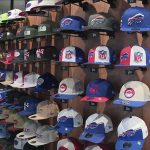For the second consecutive month, shoppers braved unfavorable shopping conditions and numerous market challenges to drive retail sales in the broader market above analysts’ expectations, although that wasn’t necessarily the case for many of the segments serving the sporting goods and outdoor active lifestyle markets.
Analysts expected a later-than-usual Easter holiday, higher rates of inflation and chilly weather during March would significantly push sales into April, but retailers serving the overall retail market ended up outperforming expectations. The International Council of Shopping Centers, which tracks 29 major retail chains, excluding Wal-Mart, reported that aggregate comps improved 2.0% for fiscal March – at the high end of the organization’s preliminary projections. Many retail analysts had predicted the first monthly sales decline since 2009 in the wake of the aforementioned factors.
The gain came despite an estimated 1 to 2 percentage point drag generated by the latest Easter holiday since 1943, which falls nearly three weeks later than Easter 2010. Economists originally expected holiday buying to be pushed deeper into April, but it appears lower unemployment numbers and pent-up demand for spring apparel has prompted consumers to start spring shopping earlier than expected.
In the outdoor market, tough winter weather conditions in March hurt sales of softgoods products (footwear + apparel) at specialty retailers, but the overall outdoor product business again outpaced the general retail market by a wide margin, posting a consolidated sales increase of 4.5% to $774.3 million for the five-week fiscal month of March ending April 2, 2011. The weakest trend for the month came out of the Discount/Mass channel as those retailers continue to struggle with a core consumer base that is more challenged by higher gas and food prices. The Independent Outdoor Specialty channel actually posted a slight decline for the month when reviewing sales of all categories (both outdoor and non-outdoor) sold through the channel in March.
The Internet channel was the only other major channel where the March sales trend in outdoor products failed to keep pace with the year-to-date trend. Full-line Sporting Goods and Chain Specialty both accelerated for the month versus the year-to-date trend.
Broken out by channel, outdoor product sales to all chain retailers improved an average of 6.0% versus the year-ago period, with Outdoor Chain Specialty shop contributing 5.1% growth for the month. Likewise, Volume retailers reported a 14.2% average sales increase of outdoor product as compared to March 2010. Among Independent Outdoor Specialty retailers, revenues of outdoor products increased a modest 2.3% versus the year-ago month.
The Outdoor Footwear sales trend in the five-week fiscal month of March fell a bit short of the overall outdoor product sales trend for the period, hurt by double-digit sales declines in the Independent Outdoor Specialty channel and a small decrease in the Outdoor Chain Specialty channel. The channels appear to have suffered a bit from the challenges of tougher prior-year comps when the barefoot/natural footwear craze started, as well as challenges from the weather side that kept specialty consumers on the slopes instead of in their sandals.
The combined outdoor specialty channels not only saw challenges versus March 2010, but also from increased competition (barefoot knock-offs in the market at half the price) and broader distribution of the hot product that drove many of the early gains last year as more business goes to running shops, Family Footwear and the Internet.
Of note, Outdoor Footwear only comprised 74.2% of all footwear sold through the combined outdoor specialty channels in March, down almost four percentage points from the 78.1% in March 2010.
Of note, Outdoor Footwear only comprised 74.2% of all footwear sold through the combined outdoor specialty channels in March, down almost four percentage points from the 78.1% in March 2010.
Meanwhile, Average selling prices (ASPs) for Outdoor Footwear dipped 2.1% in the consolidated channels tracked by SportScanInfo for OIA VantagePoint in March versus the prior-year month. ASPs fell 7.5% in March in the Independent Outdoor Specialty channel.
However, despite certain shortcomings within several key sectors, total outdoor footwear sales actually improved 3.7% versus the year-ago period due to substantial sales spikes at the internet and within Discount/Mass stores and Family/Independent footwear shops.
The Outdoor Apparel business posted a positive sales trend in the five-week fiscal month of March, but the trend fell far short of the overall year-over-year trend seen for overall outdoor product sales. Total sales of Outdoor Apparel inched up just under 2% for the month on weakness from Independent Outdoor Specialty retailers,which was challenged by a double-digit decline as late snowfalls in a number of areas of the country kept the specialty consumer thinking about one last ski run for the season rather than new spring/summer sportswear. Weather fueled the Outdoor Outerwear business even as it hurt the Outdoor Sportswear category.
By sales channel, the Independent Outdoor Specialty shops exhibited the steepest decline for outdoor apparel, falling more than 15% versus the year-ago period. Sales improved low to-mid singles within the Outdoor Chain Specialty and Sporting Goods Channels.
Of note, Outdoor Outerwear sales were up in the mid-teens in March, fueled in part by a mid-single-digit increase in average selling prices and a high-single-digit increase in unit sales. Outdoor Outerwear represented just over 36.0% of Outdoor Apparel sales in March 2011 versus 32.7% of sales in the year-ago month. Likewise, improved inventories in the Outdoor Outerwear category helped fuel sales in March 2011 and the year-to-date period, with growth coming across the board from Insulated Jackets, Softshell Jackets, Hard Shell Jackets, Convertible Jackets and Fleece Jackets. Outdoor Sportswear sales were down in strong double-digits for the month versus March 2009.
The Outdoor Hardgoods business outpaced the sales trend for the total outdoor product market in the five-week fiscal month of March, posting a 6.7% increase for the month to $375.4 million. In sharp contrast to the weaker footwear and apparel business in the Independent Outdoor Specialty channel, Outdoor Hardgoods sales jumped nearly 20% for the month in the channel. Despite a decline in Paddlesports sales to start the season, the channel’s sales trend in Outdoor Hardgoods for the month was approximately 3X the trend measured in the consolidated channels tracked by SportScanInfo for OIA VantagePoint.
Of note, the Independent Outdoor Specialty channel represented nearly 24% of total Outdoor Hardgoods sales in March in the channels tracked by SportScanInfo for OIA VantagePoint, compared to 21.3% of the total in March 2010.
Sales of Technical Backpacks jumped in strong double-digits in March as average selling prices (ASPs) in the Independent Outdoor Specialty channel increased nearly 20% for the period. ASPs in the category dipped about 3% in the Chain Specialty channel and fell nearly 5% in the Internet channel. Growth was seen in Technical Daypacks and Internal Frame Packs.
Looking ahead, another blast of cold air and winter weather hit the Northeast as the month of March came to a close, but warming trends across most of the country look to be here to stay for the duration of the spring /summer season. Based on the tremendous snow pack and late heavy snowfalls in the Sierras and elsewhere, outdoor active lifestyle enthusiasts may be skiing well into the summer this year, but those trips to the slopes should not eat into the expected surge in April retail sales.
If an improving labor market, better economic conditions and the reduction in payroll tax continue to offset concerns related to higher priced fuel and food and mounting material costs that are passed onto the consumer, summer 2011 could be a pleasant surprise for industry manufacturers and retailers.
Even more surprising, retailers in all reporting sectors outperformed estimates in March, suggesting at least a temporary rebound for consumers of all income levels. While expectations were very low for the month of March, retailers are still optimistic as the buyer-friendly Easter holiday approaches.
Looking ahead, the International Council of Shopping Centers research forecasts that total retail sales are likely to increase between 5% and 6% in April with about a one to two percentage point lift due to the later Easter.









